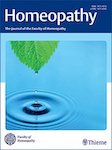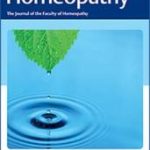Silicea terra and Zincum metallicum Modulate the Activity of Macrophages Challenged with BCG In Vitro

Background – The homeopathic medicines Silicea terra (Sil) and Zincum metallicum (Zinc) modulate macrophage activity and were assessed in an experimental study in-vitro for their effects on macrophage–BCG (Bacillus Calmette–Guérin) interaction. Methods – RAW 264.7 macrophages were infected with BCG, treated with different potencies of Sil and Zinc (6cH, 30cH and 200cH) or vehicle, and assessed 24 and 48 h later for bacilli internalization, hydrogen peroxide (H2O2) and cytokine production, and lysosomal activity. Results – Treatment with vehicle was associated with non-specific inhibition of H2O2 production to the levels exhibited by uninfected macrophages. Sil 200cH induced significant reduction of H2O2 production (p < 0.001) compared with the vehicle and all other treatments, as well as higher lysosomal activity (p ≤ 0.001) and increased IL-10 production (p ≤ 0.05). Such effects were considered specific for this remedy and potency. The number of internalized bacilli was inversely proportional to Zinc potencies, with statistically significant interaction between dilution and treatment (p = 0.003). Such linear-like behavior was not observed for Sil dilutions: peak internalization occurred with the 30cH dilution, accompanied by cellular degeneration, and IL-6 and IL-10 increased (p ≤ 0.05) only in the cells treated with Sil 6cH. Conclusion – Sil and Zinc presented different patterns of potency-dependent effect on macrophage activity. Bacterial digestion and a balanced IL-6/IL-10 production were related to Sil 6cH, though reduced oxidative stress with increased lysosomal activity was related to Sil 200cH. Degenerative effects were exclusively related to Sil 30cH, and potency-dependent phagocytosis was related only to Zinc.






Lascia un commento
Devi essere connesso per inviare un commento.